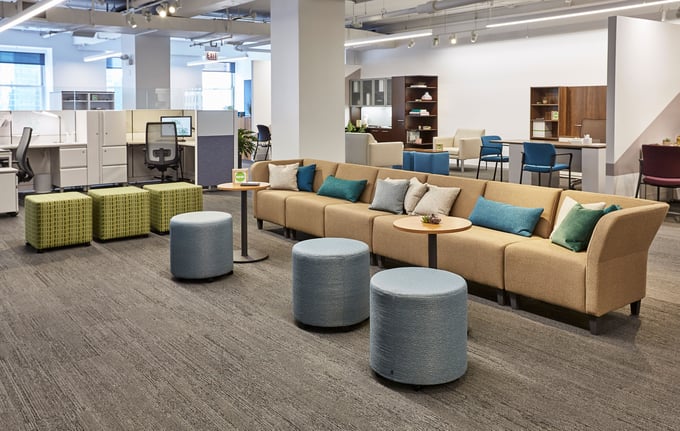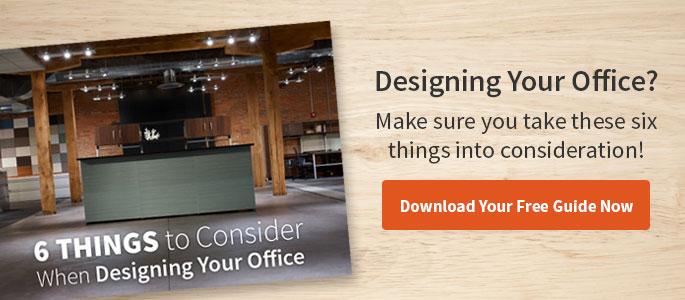More and more companies have been knocking down the physical barriers to communication and incorporating an open office plan. According to the International Facility Management Association, about 70% of U.S. offices have some type of open office plan. Companies have been shifting away from traditional office designs to cut costs and improve collaboration.

While open office plans can be an extrovert’s paradise, they can be an introvert’s personal nightmare. As a business owner, it’s important to recognize that an open office plan might not work well for everyone. To help employees of all work styles and personalities feel comfortable in the workplace, here are 6 tips for making an open office work:
1) Establish a “Do Not Disturb” Signal
One of the drawbacks of working in an open office is that there’s nowhere to hide. Employees can no longer rely on the sanctuary of their cube walls. They may be constantly interrupted by chatty or unfocused employees. On the way to the bathroom or the break room for a coffee, employees may be tempted to stop by coworkers’ desks and strike up a conversation. Or, they may turn to someone sitting next to them to ask a question.
While innocent enough, these 5-minute conversations break the concentration of employees. To help employees stay on task and meet crucial deadlines, create “do not disturb” signs that employees can place on their desks as a nice way to say “please don’t bother me.” Or, you could allow employees to wear headphones to help them concentrate in a noisy environment. That way, employees won’t feel like they have to come into work early or stay late to avoid talkative coworkers.
While these signs can help improve productivity, make sure your employees aren’t abusing them and using them all the time. Employees need to collaborate and bounce ideas off of each other to drive business innovation. If they’re pretending to be busy, you may need to reevaluate your strategy and look into other options.
2) Keep Noise to a Minimum
When the cube walls come down, and employees can see each other, they’re more likely to shout across the room and stop by each other's desks. As a result, open office plans tend to be noisier than traditional office designs. While discussion and activity indicate a thriving workplace, it can disrupt your employees’ focus.
Help everyone maintain productivity by setting some ground rules. Let employees know they’re welcome to listen to music, but only if they wear headphones and keep the music to a considerate volume level. Also, ask employees to eat meals in the break room rather than at their desks. There’s nothing more disruptive than the sound of chewing and utensils clinking.
3) Designate Meeting and Group Work Areas
In an open office space, employees may gather around one employee’s desk and discuss ongoing projects. While meetings are necessary for a successful workplace, the noise can disturb other employees nearby who are not part of the meeting.
For this reason, it’s important to designate areas, preferably away from the main work area, where employees can participate in impromptu meetings. Incorporate lounge areas where employees can meet when all the conference rooms are full. Make sure there’s ample seating so that employees aren’t forced to sit on the floor.
4) Utilize Instant Messaging Applications
Instant messaging applications such as Slack or Gchat are effective ways to communicate in an open office plan. While it may be tempting for employees to shout a question across the office, or to walk over to a coworker’s desk, doing so will disrupt everyone else in the room. Explore different instant messaging applications to see which one works best for your office.
5) Keep the Office Clean and Tidy
Piles of documents and clutter around the office are more than just an eyesore; they can be distracting to employees as well. Ask employees to keep their desks tidy to improve productivity. Make sure employees have plenty of drawers and storage for their belongings and office supplies. Also, if you’re struggling to find room for desks or a new printer, invest in more storage or take advantage of underutilized space. You’ll keep the office well-organized for maximum productivity!
6) Set Guidelines for Cell Phone Use
There are going to be times when your employees need to take personal calls. It’s inevitable. To keep phone conversations from distracting other employees, set general guidelines for personal calls. You could ask employees to step outside to take personal calls (at least in warmer months). Or, you could incorporate private rooms where employees can take personal calls, within reason, or work in silence. Sticking to some basic rules will help keep interruptions to a minimum.
Whether you’re looking for creative ways to optimize your current open office, or you’re just now making the transition, these open office tweaks will help you improve employee satisfaction and productivity.



